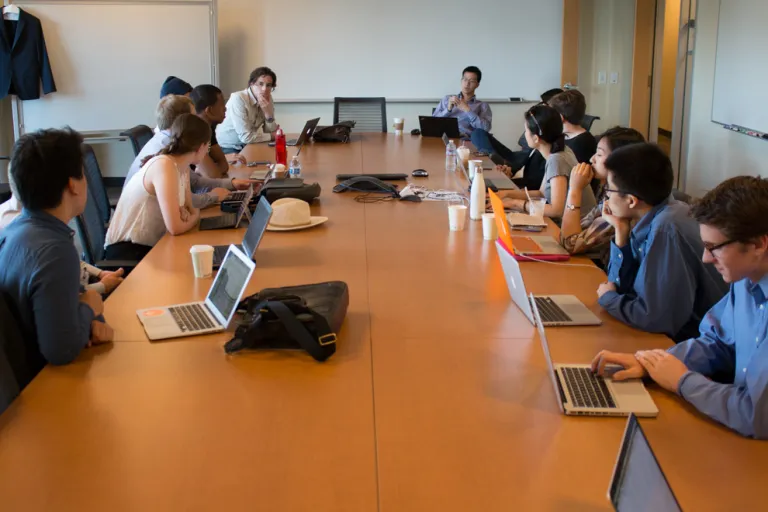Together with their teaching staff, the 14 students of Econ 183: “The Cardinal Fund” act as the wealth manager for the $1 million Cardinal Fund provided by the Stanford Student Enterprises (SSE) endowment. The class has seen questionable investment returns but remains a unique learning experience for its members.
Divided into teams of Health Care and Materials, Information Technology and Financials, Industrials and Energy and Consumer and Utilities, students pitch which companies they want to buy and sell stock in. Although the class has relative autonomy with decisions, the teaching team offers guiding advice.
At the start of class, class president Caroline Frost ’16 goes over logistics. Then Kevin Mak, a lecturer in management at the GSB and director of the Real-time Analysis and Investment Lab (RAIL), begins exchanging with the students, discussing percentages off “the index” and the class’s average cash balance. Mak co-teaches the group of juniors and seniors with Jonathan Berk, the A.P. Giannini Professor of Finance in the Graduate School of Business (GSB).
As the class progresses, decisions must be made. Diego Torres Patino, the class’s teaching assistant, facilitates a blind vote among the students to determine which stocks they invest in. In a 9-4 decision, they voted to invest in IWM, the iShares Russell 2000 Index Fund.
Cutting their losses and looking to the future
At the class’s inception in spring 2015, it was awarded $1 million from the SSE to manage various well-researched investments. As of April 5, 2016, the amount it manages has fallen to $866,400, a return of -13.36 percent.
The returns differ with the some of the largest stock market indexes in the United States: the S&P 500 Index and the Dow Jones Industrial Average, which have dropped 2.63 percent and 2.39 percent respectively since April 20, 2015.
However, the class compares their results to an index linked to the fund when they took over management. The index is called the Russell 2000, which is down 13.37 percent since April 20, 2015.
“Most of our money is invested in the index portfolio we took over, so we measure our performance on whether we under or out-perform that,” explained class member Ricky Mariscal ’17. “We’re pretty much tracking that.”
According to Frost, however, the numbers aren’t the only way the class measures success.
“We evaluate ourselves in sort of a twofold way,” Frost said. “Of course we are managing money and have a fiduciary duty, but it is also about an educational experience.”
This educational experience isn’t always low-stress. Because the students are dealing with real money, their decisions can also lead to real losses. For some of the students, this has meant viewing the class — and success in the class — through a different paradigm.
“I think Stanford students have been conditioned to have to be right 95 percent of the time,” said Matthew Chen ’16. “With finance, as long as you’re right more often than your peers, you can do a lot of good.”
Class structure, application and required commitments
Unlike most classes at Stanford, which consist of a teaching team and students, members of Econ 183 each play different roles in the group. Frost, as president, serves as a go-between for the students, teaching team and SSE. Other roles include Trent Meinke ’16, chief investment officer, and Chenyi Shi ’17, chief compliance officer. According to Mariscal, the seniors tend to take on extra leadership.
“It’s a steep learning curve, but the seniors in each subgroup kind of hold your hand,” Mariscal said.
According to the course site, applications are typically collected in May and require a six quarter commitment. Applicants must be sophomores or juniors who plan to coterm in order to fulfill the two-year commitment. Additionally, students must have taken Econ 102A: “Introduction to Statistical Methods for Social Scientists” before entering the program. Once accepted, students are required to take Econ 190: “Introduction to Financial Accounting” in their first quarter of the program and Econ 135: “Finance for Non-MBAs” or equivalent by the end of their first year in the program.
Although there are more traditional, abstract economics classes that are required as prerequisites, Mak emphasizes that the value of Econ 183 is in its applied nature.
“Investment is the most conducive to experiential learning because it’s very real life,” Mak said. “The fundamentals you can learn anywhere, but the hands on ‘let’s look at these companies and understand what they’re doing’ is only done by putting in a lot of time.”
Correction: A previous version of this article incorrectly stated that the Cardinal Fund began investing in spring 2014, not spring 2015, and thus provided incorrect benchmarks for the fund’s performance. Shi’s class year was also inaccurate. The Daily regrets these errors.
Contact Ada Statler-Throckmorton at adastat ‘at’ stanford.edu and Max Pienkny at maxp123 ‘at’ stanford.edu.
